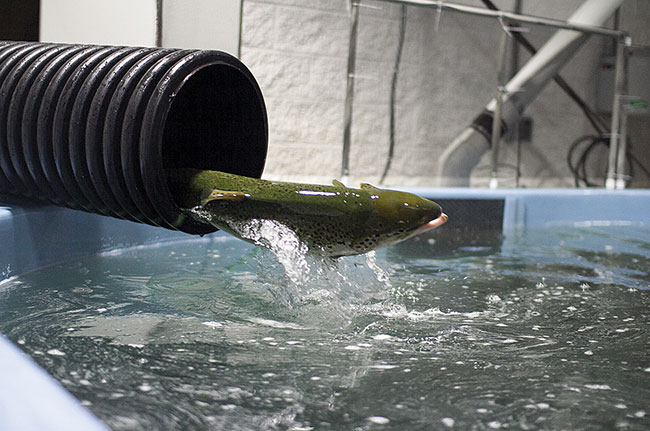
Eliminating off-flavour in Atlantic salmon
May 14, 2021
By Ruby Gonzalez
 Study investigates the effects of temperature and water exchange in depuration tanks when eliminating geosmin from Atlantic salmon
Photo: The Conservation Fund
Study investigates the effects of temperature and water exchange in depuration tanks when eliminating geosmin from Atlantic salmon
Photo: The Conservation Fund Water renewal in depuration systems for Atlantic salmon will significantly increase the removal of geosmin but the temperature of the water has no enhancing effect.
This was the conclusion of Dr. Edward Schram’s doctorate thesis “Geosmin removal from fish” at the Wageningen University & Research in the Netherlands, which aimed to investigate the effects of temperature and water exchange in depuration tanks when eliminating geosmin from Atlantic salmon (Salmo salar).
Fish loaded with geosmin were depurated for 144 hours, during which they were subjected to combinations of water exchange (stagnant water or a water exchange rate of ~1200 L/kg fish/d) and temperature (~11.5 or ~14.5°C) treatments.
The elevated temperature of 14.5°C did not enhance geosmin elimination from Atlantic salmon. This was possibly because in the tanks with water exchange, temperature treatments did not cause differences in oxygen levels and thus gill ventilation rates, wrote Schram.
At the end of the experiment, geosmin level in the fish in stagnant water (at 11.6°C) was about ten times higher than in the fish in the tanks with water exchange.
Schram says his experiment showed that “removal of excreted geosmin from the direct environment of this fish is needed to obtain maximal geosmin elimination from the fish.”
The elimination of off-flavor gives the fish better market price and acceptance, says Schram. He said increasing the water renewal rate will also make the cleansing process faster, which reduces the stress on the fish.
Fewer losses of biomass (due to less stress) and shorter time in the depuration facility also mean a smaller and cheaper facility. “However, increasing water exchange may also increase costs because of higher water consumption. Costs and benefits remain balanced,” he added.
“Off-flavor depuration systems are generally operated with low water renewal rates to limit water consumption and at temperatures below normal rearing temperatures. Also, fish are generally not fed during depuration. It seems the aquaculture industry optimized depuration processes towards minimal operational costs, water use, energy use and biomass loss rather than optimal removal of geosmin – and 2-methylisoborneol (MIB) – from fish stocks,” he said. MIB is another compound contributing to the musty odor.
Water renewal in depuration systems for Atlantic salmon will significantly increase the removal of geosmin but the temperature of the water has no enhancing effect.
This was the conclusion of Dr Edward Schram’s doctorate thesis “Geosmin removal from fish” at the Wageningen University & Research in the Netherlands, which aimed to investigate the effects of temperature and water exchange in depuration tanks when eliminating geosmin from Atlantic salmon (Salmo salar).
Fish loaded with geosmin were depurated for 144 hours, during which they were subjected to combinations of water exchange (stagnant water or a water exchange rate of ~1200 L/kg fish/d) and temperature (~11.5 or ~14.5 °C) treatments.
The elevated temperature of 14.5°C did not enhance geosmin elimination from Atlantic salmon. This was possibly because in the tanks with water exchange, temperature treatments did not cause differences in oxygen levels and thus gill ventilation rates, wrote Schram.
At the end of the experiment, geosmin level in the fish in stagnant water (at 11.6°C) was about ten times higher than in the fish in the tanks with water exchange.
Schram says his experiment showed that “removal of excreted geosmin from the direct environment of this fish is needed to obtain maximal geosmin elimination from the fish.”
The elimination of off-flavor gives the fish better market price and acceptance, says Schram. He said increasing the water renewal rate will also make the cleansing process faster, which reduces the stress on the fish.
Fewer losses of biomass (due to less stress) and shorter time in the depuration facility also mean a smaller and cheaper facility. “However, increasing water exchange may also increase costs because of higher water consumption. Costs and benefits remain balanced,” he added.
“Off-flavour depuration systems are generally operated with low water renewal rates to limit water consumption and at temperatures below normal rearing temperatures. Also, fish are generally not fed during depuration. It seems the aquaculture industry optimized depuration processes towards minimal operational costs, water use, energy use and biomass loss rather than optimal removal of geosmin – and 2-methylisoborneol (MIB) – from fish stocks,” he said. MIB is another compound contributing to the musty odor.





